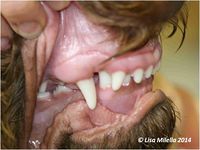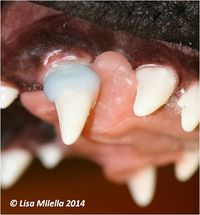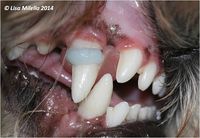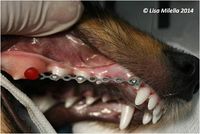Difference between revisions of "Orthodontic Treatment"
Ggaitskell (talk | contribs) (Created page with "==Prevention and Treatment of Malocclusion== Prevention is always better than treatment. Early recognition of a problem is essential to avoid discomfort and pain to the animal...") |
|||
| (13 intermediate revisions by 2 users not shown) | |||
| Line 1: | Line 1: | ||
| − | == | + | {{OpenPagesTop}} |
| − | + | ==Introduction== | |
| + | [[File:Canine tooth malocclusion.jpg|200px|thumb|right|Mandibular canine tooth causing damage to the palatal mucosa (lance canines).]] | ||
| + | [[File:Orthodontics - inclined plane 1.jpg|200px|thumb|right|Orthodontics - inclined plane 1]] | ||
| + | [[File:Orthodontics - inclined plane 2.jpg|200px|thumb|right|Orthodontics - inclined plane 2]] | ||
| + | [[File:Orthodontics - lance canines.jpg|200px|right|thumb|Orthodontics - lance canines]] | ||
| + | Orthodontic treatment is indicated in cases of '''[[Dental Malocclusion|dental malocclusion]]'''. | ||
| − | + | Orthodontic movement of [[Teeth - Anatomy & Physiology|teeth]] can be described as '''prolonged application of pressure to the tooth, resulting in movement of the tooth as the [[Bones - Anatomy & Physiology|bone around it remodels]]'''. Bone on the compression side undergoes lysis allowing the tooth to move and bone formation on the tension side ensures that the tooth stays in the new position. In the ideal situation bone lysis and bone formation should be in equilibrium. In most practical situations, there is an imbalance and lysis occurs more rapidly. A retention phase maintaining the tooth in the new position while allowing time for bone formation is, therefore, necessary in many cases. | |
| − | The | + | The optimal orthodontic force is one that moves teeth rapidly without resulting in structural damage, while causing the least amount of discomfort or pain. Factors that need to be considered for any orthodontic appliance are the '''magnitude''' of the force, the '''distribution''' of the force and the '''duration''' of the force. The ideal force is a '''light continuous force'''. Heavy continuous forces are damaging and should be avoided. Apart from the orthodontic forces applied, normal growth processes and forces from the [[Lips|lips]], [[Cheeks|cheeks]] and [[Tongue - Anatomy & Physiology|tongue]] resting on the teeth will determine the outcome of the treatment. |
| − | + | The most common orthodontic procedures in veterinary medicine include moving the mandibular canines when they are causing trauma to the palatal mucosa using an inclined plane, or in the case of [[Dental Malocclusion#Dental Malocclusion|lance canines]]. | |
| − | |||
==Indications== | ==Indications== | ||
| − | In humans, medical (predisposition to periodontal diseases), functional (alteration of mastication or speech) and psychological (alteration of | + | In humans, medical (predisposition to [[Periodontal Disease|periodontal diseases]]), functional (alteration of [[Mastication|mastication]] or speech) and psychological (alteration of aesthetics) problems relating to malocclusion are the primary reason for orthodontic treatment. In human orthodontics, whether malocclusion is hereditary or acquired is not a consideration when planning treatment. This is in contrast to veterinary orthodontics where '''aesthetics and ethical concerns are linked''', and treatment for the sole purpose of showing dogs or cats cannot be encouraged. The aim of any treatment is primarily to make the animal comfortable; aesthetics are a secondary consideration. It is essential to determine if the presenting malocclusion is hereditary or not. Orthodontic correction of a malocclusion is contraindicated where the malocclusion is hereditary unless the animal is also neutered. The rationale for this is to avoid spread of inherited malocclusion within a breed. |
==Contraindications== | ==Contraindications== | ||
| Line 19: | Line 23: | ||
==Complications== | ==Complications== | ||
| − | Possible complications of orthodontic movement of teeth include pulpal disease, external root resorption, tooth mobility and pain. In short, the outcome of an orthodontic procedure is rarely predictable and needs frequent monitoring based on clinical signs and radiography. | + | Possible complications of orthodontic movement of teeth include [[Pulp and Periapical Disease|pulpal disease]], external root resorption, tooth mobility and pain. In short, the outcome of an orthodontic procedure is rarely predictable and needs frequent monitoring based on clinical signs and [[Intra-Oral Radiography - Small Animal|radiography]]. |
| − | |||
| − | {{ | + | {{Lisa Milella written |
| − | [[Category:Dental Surgical Procedures]][[Category: | + | |date = 21 August 2014}} |
| + | |||
| + | {{Waltham}} | ||
| + | |||
| + | {{OpenPages}} | ||
| + | |||
| + | [[Category:Dental Surgical Procedures]] | ||
| + | [[Category:Waltham reviewed]] | ||
Latest revision as of 14:11, 2 November 2014
Introduction
Orthodontic treatment is indicated in cases of dental malocclusion.
Orthodontic movement of teeth can be described as prolonged application of pressure to the tooth, resulting in movement of the tooth as the bone around it remodels. Bone on the compression side undergoes lysis allowing the tooth to move and bone formation on the tension side ensures that the tooth stays in the new position. In the ideal situation bone lysis and bone formation should be in equilibrium. In most practical situations, there is an imbalance and lysis occurs more rapidly. A retention phase maintaining the tooth in the new position while allowing time for bone formation is, therefore, necessary in many cases.
The optimal orthodontic force is one that moves teeth rapidly without resulting in structural damage, while causing the least amount of discomfort or pain. Factors that need to be considered for any orthodontic appliance are the magnitude of the force, the distribution of the force and the duration of the force. The ideal force is a light continuous force. Heavy continuous forces are damaging and should be avoided. Apart from the orthodontic forces applied, normal growth processes and forces from the lips, cheeks and tongue resting on the teeth will determine the outcome of the treatment.
The most common orthodontic procedures in veterinary medicine include moving the mandibular canines when they are causing trauma to the palatal mucosa using an inclined plane, or in the case of lance canines.
Indications
In humans, medical (predisposition to periodontal diseases), functional (alteration of mastication or speech) and psychological (alteration of aesthetics) problems relating to malocclusion are the primary reason for orthodontic treatment. In human orthodontics, whether malocclusion is hereditary or acquired is not a consideration when planning treatment. This is in contrast to veterinary orthodontics where aesthetics and ethical concerns are linked, and treatment for the sole purpose of showing dogs or cats cannot be encouraged. The aim of any treatment is primarily to make the animal comfortable; aesthetics are a secondary consideration. It is essential to determine if the presenting malocclusion is hereditary or not. Orthodontic correction of a malocclusion is contraindicated where the malocclusion is hereditary unless the animal is also neutered. The rationale for this is to avoid spread of inherited malocclusion within a breed.
Contraindications
- Ethical considerations
- Show animals
- Lack of owner compliance
- Lack of patient tolerance and compliance
Complications
Possible complications of orthodontic movement of teeth include pulpal disease, external root resorption, tooth mobility and pain. In short, the outcome of an orthodontic procedure is rarely predictable and needs frequent monitoring based on clinical signs and radiography.
| This article was written by Lisa Milella BVSc DipEVDC MRCVS. Date reviewed: 21 August 2014 |
| Endorsed by WALTHAM®, a leading authority in companion animal nutrition and wellbeing for over 50 years and the science institute for Mars Petcare. |
Error in widget FBRecommend: unable to write file /var/www/wikivet.net/extensions/Widgets/compiled_templates/wrt66279a5566c244_81056029 Error in widget google+: unable to write file /var/www/wikivet.net/extensions/Widgets/compiled_templates/wrt66279a556b2043_66315549 Error in widget TwitterTweet: unable to write file /var/www/wikivet.net/extensions/Widgets/compiled_templates/wrt66279a556eab69_22160994
|
| WikiVet® Introduction - Help WikiVet - Report a Problem |



